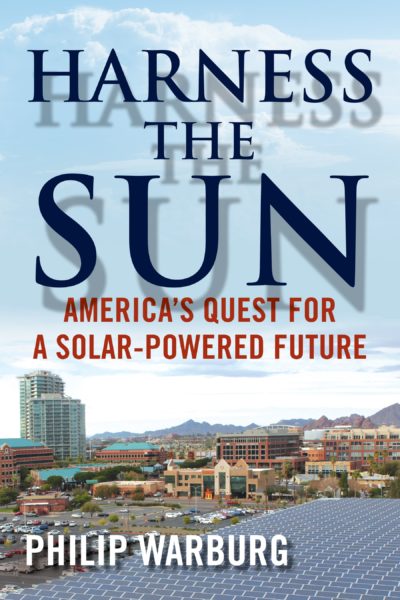A new book takes readers on a fascinating exploration of the many faces of solar energy, from rooftops to wide open spaces, from small-scale to large, from coast to coast and plenty of places in between. Harness the Sun: America’s Quest for a Solar-Powered Future, by Philip Warburg, covers an exciting range of solar technologies, issues, locations, and opportunities, in a compelling, easy-to-read style that will have you wondering why we aren’t doing even more of this, and how you can get a piece of the action.
As a solar enthusiast (can you tell?) and a reviewer of a draft of this book, I’m pleased to have it now available to the public.
 Warburg brings a great perspective to the field of solar energy as a seasoned environmental lawyer and a former president of the Conservation Law Foundation.
Warburg brings a great perspective to the field of solar energy as a seasoned environmental lawyer and a former president of the Conservation Law Foundation.
And the book makes a strong case for acting on solar, for embracing a technology that in recent years has risen to become a serious challenge to the status quo, and for reclaiming the mantle of global leadership in this area:
As one of the biggest producers of the greenhouse gases that threaten our global environment, America has a duty to lead the way, rather than lag behind, in making these momentous shifts [toward solar power]. Through the personal choices we make, the policies we adopt, the technical genius we apply, and the entrepreneurial spirit we engage, we can make a difference.
Harness the Sun makes that case by looking at what’s going on now across the country, and what more could be happening.
Up on the roof
The starting point for exposure to solar for many of us is rooftop solar, and Harness the Sun begins right there—including with Warburg’s own experiences at going solar at home. The book looks at the potential for solar photovoltaic (PV) systems on homes at a range of scales, from systems bringing stable power prices in middle-class neighborhoods to ones offering opportunities for underserved communities.

Rooftop solar to the rescue Photo: Elenathewise/iStock
His focus then moves to commercial, industrial, and institutional installations—“ballfields and boxtops”—with solarized locations ranging from the New England Patriots’ home base, Gillette Stadium in Foxboro, Massachusetts, through big installations on flat roofs and campuses from Arizona to New Jersey.
Where the sun shines much brighter
Warburg takes a look at whole communities embracing solar. That includes Lancaster, California, whose very conservative mayor sees the tremendous opportunity that solar represents, and has pledged to make the city/town “the solar capital of the world.”
As Harness the Sun details, solar can be an appropriate fit for reusing brownfields, old, potentially contaminated industrial sites in need of redemption. And, when done well, for taking advantage of the tremendous potential of even relatively small swaths of our deserts.

PV comes in all shapes, sizes, and degrees of undulation. Photo: John Rogers
Tribal lands, too: Warburg cites the U.S. Department of Energy in saying that “the sun shines much brighter on Native American lands than on the rest of the nation,” with tribal areas representing 2% of U.S. land, but 5% of our technical solar potential.
While much of the book’s attention—like the solar market’s—is on PV, Warburg doesn’t leave out concentrating solar power (CSP), a wholly different way of tapping the sun that lends itself to record-breaking projects.
Harness the Sun is bullish on solar, but doesn’t ignore the challenges, present and future. Issues around module recycling, for example, or bird impacts, or disruption to electric utilities who like things just they way they’ve been for the last 100 years.
But the book’s focus is on the opportunities to make clean energy not only an ever-broader piece of our electricity mix and our move toward a lower-carbon economy, but also a driver of economic development, with all the jobs that come with manufacturing, sales, installation, and project development, for example.

Concentrating solar power also has a role to play (Credit: NREL)
“Our obligation and privilege”
In wrapping up Harness the Sun, Warburg is even more eloquent about what solar can mean for all us:
A new generation of entrepreneurs and engineers is weighing in with vision and creativity, opening up new frontiers for solar development, and politicians across the political spectrum are waking up to the opportunities that accompany a genuine commitment to renewable energy. The tools for advancing a more sustainable energy future are within reach. It is our obligation and privilege to use them.
Obligation and privilege. I’m with you, Mr. Warburg.
Additional resources:
- For a (much) shorter treatment of technologies and issues covered in Harness the Sun, check out UCS’s Solar Power on the Rise.
- If you enjoy Harness the Sun, check out Phil Warburg’s previous book on the very different but equally exciting world of wind energy: Harvest the Wind: America’s Journey to Jobs, Energy Independence, and Climate Stability.

